Toshiba has produced a number of exceptional television displays over the years and their 2009 range of LCD TVs are set to be just as brilliant. So without further ado, let’s move onto our review of the Toshiba 32RV635DB, an entry level 1080p LCD television model which does not feature true 24p support.
<!-- google_ad_client = 'pub-2887677957235196'; google_ad_slot = '4990177225'; google_ad_width = 336; google_ad_height = 280; //-->
Note: The specific model we reviewed was the Toshiba 32RV635DB (denoting the 3-pin-plug British version) which may be sold as Toshiba 32RV635D, Toshiba 32RV635, or Toshiba 32RV635DB by high-street stores like John Lewis, Comet and Currys, or online retailers such as Amazon or Dixons. These terms may be used interchangeably throughout this review to refer to the same model.
Considering its current retail price, the aesthetics and build quality of the Toshiba 32RV635DB is quite remarkable. One could easily believe it to be of higher value. The plastic used to construct the front casing is exceptionally tough and can probably withstand a hurricane. I’ve never seen an LCD TV with such attribute thus far.
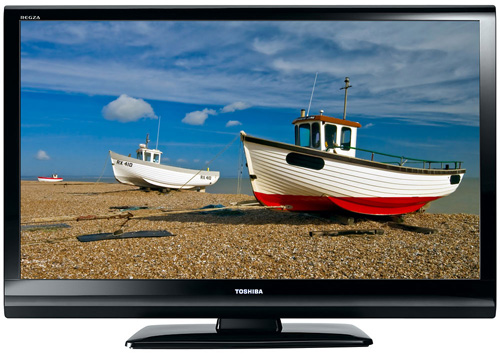
In addition, the illuminated logo as well as the piano finish adds extra lushness to the Toshiba 32RV635DB. Overall, I admire the conventional yet contemporary design chosen by Toshiba.
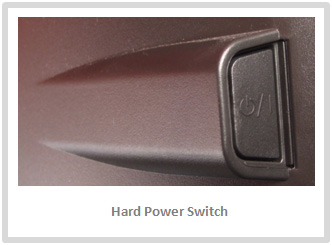
For those who are green minded, I am happy to inform that all RV series feature a hard power switch located near the rear-left of the panel. It allows complete shutdown of the panel during prolonged absences.
The location of the connection ports is in keeping with today’s standards. They are easily accessible and well constructed.
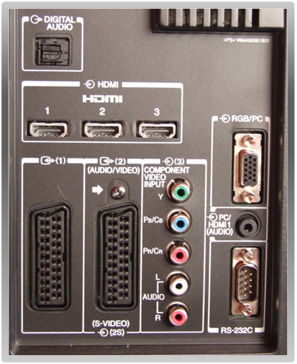 |  |
Port Listing: 4 HDMI, 2 SCARTs, Headphone Jack (with Independent Volume Control), S-Video, Composite Video, Common Interface, Component Video, Digital Audio Out (Optical/Toslink), RF In and D-Sub.
Toshiba has chosen to completely revamp the GUI for the 2009 models. The layout, font, colour and icons are all well thought-out and in keeping with current standards. The main menu features all the options one could wish for (including gamma, greyscale and 3D colour management).
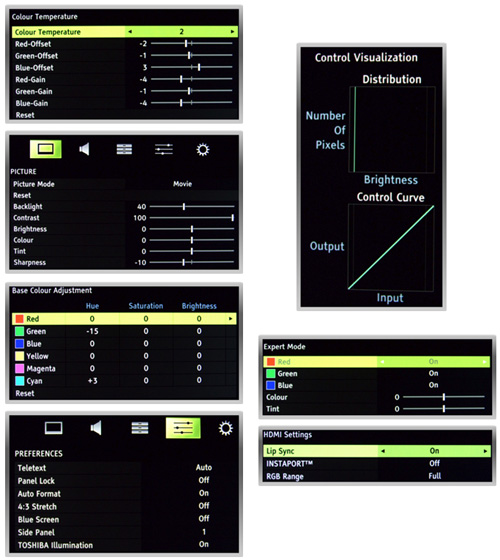
The GUI also offers additional option usually not found in low/ mid-range displays. Features include the ability to select wide range of colour temperatures, distribution and control curve graphs, black/ white level, the option to independently enable and disable primary colours to aid in calibration, image position, lip sync (HDMI), Instaport (HDMI) and wide range of aspect ratio options.
The long awaited Instaport by Silicon Image is a must have feature for those who own Sky HD or Virgin HD. With the Instaport engaged, the 32RV365D detects new sources and resolution within one second, compared to 2.5 seconds (disengaged).
The GUI also features independent source and resolution customisation, which allows users to customise the image according to the source and resolution.
Note: [Picture Mode], [Aspect Ratio], [Sleep Timer] and [Media Player] can be accessed via the [Quick Menu].

The supplied remote control is basic yet effective. It is safe to say the remote should be stowed away at most times as it’s the only device with the capacity to reveal the panel’s true value. Unfortunately that may not be possible because the Toshiba 32RV635DB fails to save the preferred aspect ratio. So during resolution and source cycles, the user must manually re-enable the preferred aspect ratio via the tools option found on the remote. It can be aggravating at times, but tolerable in my opinion.
Greyscale and Gamma accuracy are vital for portraying accurate representation of a given image. Therefore, the display must be calibrated to a set of standards used by the industry. In the case of HDTVs, the set standard for colour space is Rec. 709 (which is similar to sRGB), and both standards share the same white point (D65) and gamma value (2.2).
Greyscale calibration ensures all greys between black and white are free from colour dominance, which is achieved by assigning the RGB values to 6500K (CCT) colour temperature. Unfortunately, it’s not possible for a display to yield 100% accuracy. So the goal is to maintain errors within acceptable levels.
Thanks to the vast options provided by Toshiba, I was able to obtain excellent greyscale results.
Note: The results below were obtained by placing the measurement device at the centre of the screen. It is done to ensure error values are kept to a safe minimum.
 |
| Pre-calibration CCT with Colour Temperature set to 2 in [Movie] mode |
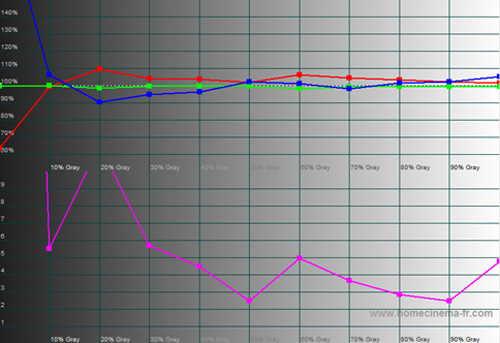 |
| Pre-calibration RGB tracking & dEs with Colour Temperature set to 2 |
 |
| Post-calibration CCT in [Movie] mode |
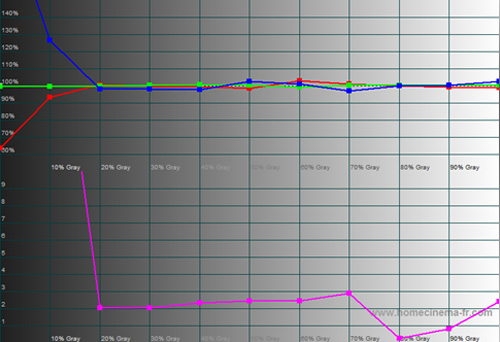 |
| Post-calibration RGB tracking & dEs in [Movie] mode |
 |
| Pre-calibration gamma in [Movie] mode |
 |
| Post-calibration gamma in [Movie] mode |
The Colour Management System is far from perfect, but it’s effective in minimising decoding errors.
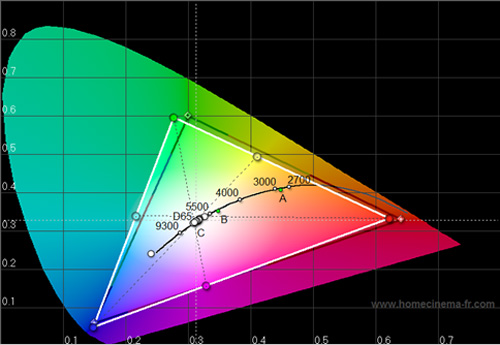 |
| Pre-calibration CIE chart with reference to HD Rec. 709 |
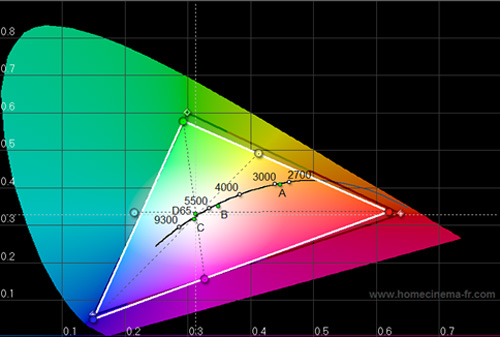 |
| Post-calibration CIE chart with reference to HD Rec. 709 |
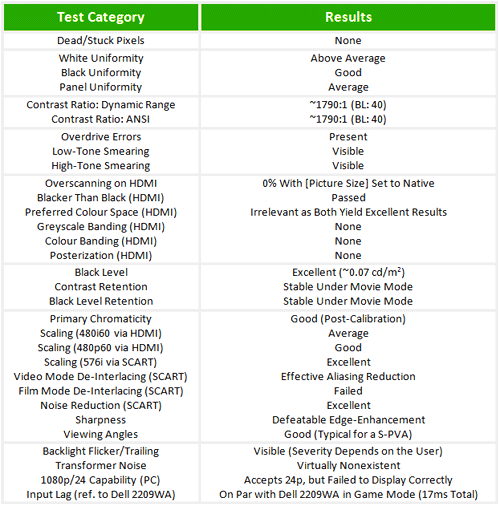
| Default [Dynamic] mode | ~94 watts |
| Calibrated [Movie] mode | ~60 watts |
| Standby | ~3 watts |
| Hard Off | <1 watt |
The Toshiba 32RV635DB produced good black and (above average) white uniformity. During pure white test (100IRE), I was able to detect the classic red and green tinting. Backlight bleeding was negligible and the panel uniformity was typical for a consumer grade display. There were a few visible defects and imperfections across the panel, which does fairly hinder calibration accuracy.
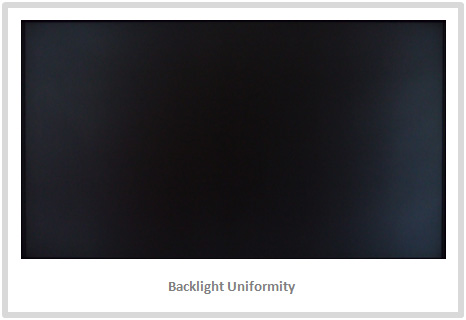
The Toshiba 32RV635DB in [Movie] mode with white level (contrast) set to maximum yielded excellent dynamic range and ANSI of ~1790:1, which is typical for an S-PVA based panel. Black levels could be further improved by enabling [Active Backlight Control] at the cost of APL (Average Picture Level).
With my usual tests based on PixPerAn, I was able to detect serious overdrive errors. Smearing was highly evident on both low and high tone shades.
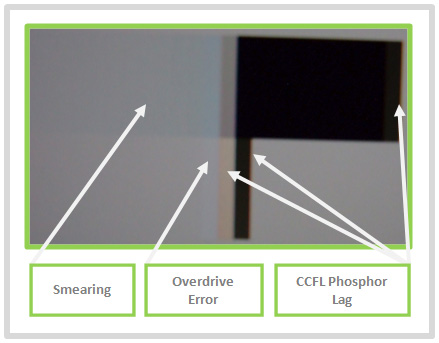
The LCD module embedded in our Toshiba 32RV635DB test model was designed and manufactured by Samsung (S-PVA), so Toshiba shouldn’t be placed at the firing line. However, at some point, they must have been aware of the issue.
![]()
Thankfully, the effect of overdrive errors during passive viewing is minute, which highly favours non-gamers. Applying certain amount of viewing distance also helps to diminish the effect. However, visible colour blends and trailing can be perceived within localised regions on screen if the motion is actively tracked during high-contrasted scenes.
The image below illustrates motion smearing at its peak.
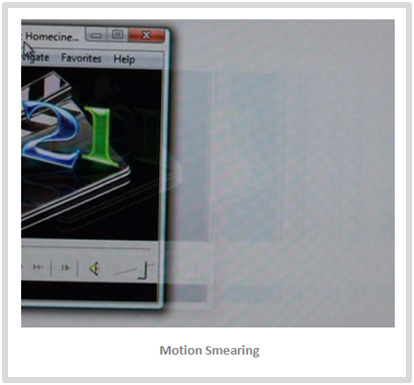
During extreme contrast scenarios, users may experience a form of image retention lasting less than a second (see image below). Rest assured it is the effect of slow black to white response time caused by incorrectly configured overdrive. However, I fear true image retention may occur as the panel continues to age.
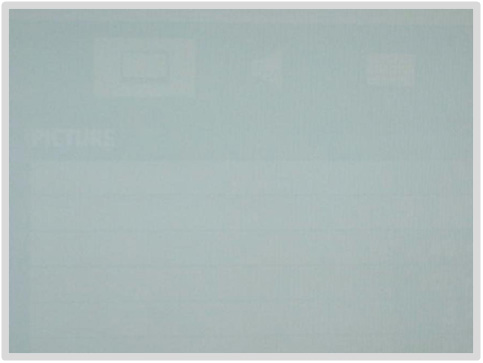
Overscan can be configured via the tools option found on the remote. During each resolution and source cycle, it reverts to its default setting; so manual intervention is necessary.
The Toshiba 32RV635DB LCD HDTV accepts both 0-255 and 16-235 formats. It also accepts a wide range of VESA resolutions (timings):
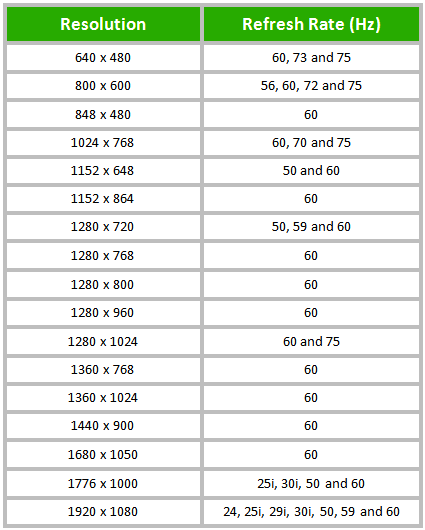
The Toshiba 32RV635DB LCD television suffers from the common backlight flicker and flicker-induced trailing, but thankfully only trailing is perceivable. If you’re extremely sensitive to such phenomenon, try to invest in a LED based panel.
The S-PVA embedded within the Toshiba 32RV635DB yield above average viewing angles. However, due to the VA mode, some shifts in colour, gamma and contrast are unavoidable.
The Toshiba 32RV635DB supports full 1:1 pixel mapping as well as the option to configure edge-enhancement with a high level of accuracy.
For evaluating image quality in the real world, we used a series of images known to expose even the most hidden artefacts and errors.
Note: The following three tests were conducted under [Movie] mode.

The Toshiba 32RV635DB yielded good results out of the box. Skin tones were reasonably warm and rendered with enough accuracy. The mass shades of warm colours that envelop Charlize Theron’s face, neck and chest were clearly identifiable. However, the overall image lacked contrast and the skin tones slightly edged towards the red.
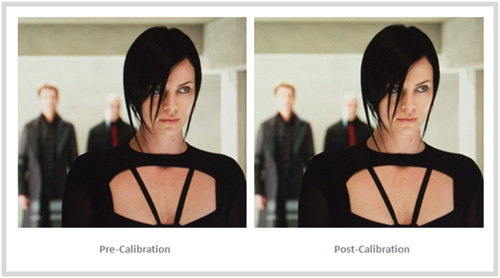
The greyscale and CMS controls allowed us to rectify these minor kinks. We immediately noticed overall improvements in luminance and colour accuracy, which also increased the level of perceivable depth.

We used the image above to detect visual inaccuracies in greyscale, gamma and black crush; and the performance of the Toshiba 32RV635DB HDTV was more than acceptable. There wasn’t any visible evidence of serious black crush, nor could I detect any errors in gamma. However, there were obvious signs of colour dominance (notably red and blue). Having said that, the majority of users probably won’t be able to spot these errors without a reference display.

After greyscale calibration, the rendered image was on par with one of our reference model (the Dell 2209WA).

Similar to the initial test, the image above was rendered with enough accuracy, though the lack of contrast resulted in a slightly dulled appearance. The colour also appeared to be rather desaturated (at default 50).

After calibration, there was an immediate improvement. The image had a sense of depth and improved contrast. Shadow details were also visible with minor crush (which is unavoidable due to the VA mode).
High-def materials on the Toshiba 32RV635DB LCD television fared well as expected. Images were beautifully rendered with pin-sharp accuracy. The excellent black levels and lack of image artefacts complemented our HD contents. Shadow details were clearly visible but there was minor crush due to the VA design.
Surprisingly, video noise was virtually non-existent, which is rather odd for a panel exhibiting overdrive issues. We were also unable to detect any motion-related overdrive errors due to the method of perception.
The lack of even pulldown did act as a minor distraction. But due to its size and price point, it shouldn’t be considered a serious issue unless the user is highly sensitive to motion.
The Toshiba 32RV635DB LCD TV produced excellent results with negligible noise via RGB SCART. The commonly seen colour bleeds and visual artefacts were virtually non-existent. In fact, the image can be compared to a SD CRT.
Scaling: The scaling algorithm embedded within the Toshiba 32RV635DB LCD is somewhat on par with the ATI HD4XXX series graphics cards. However, up-scaling 480i and 576i via HDMI seemed a little average compared to 480p and 576p. Having said that, the Toshiba 32RV635DB did a remarkable job of up-scaling SD contents via SCART thanks to the accurately configured edge-enhancement algorithm (also known as Resolution+).
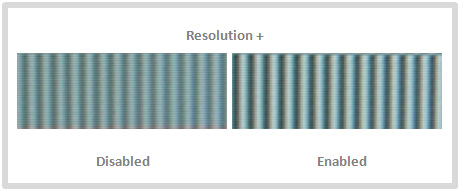
Note: Resolution+ can only be applied to SD and ED contents/ formats.
Film and Video Mode De-Interlacing: The Toshiba 32RV635DB did a good job of minimising aliasing during de-interlacing of high-motion contents. However, the LCD television failed to detect and process 2:2 pull-down, though this can be outsourced to a dedicated DVD player. So it only affects broadcast contents, which can also be outsourced if necessary.

Digital Noise Reduction: Surprisingly, enabling noise reduction did not cause any adverse motion-related artefacts (e.g. smearing). The motion and saturation levels remained true to the content.
The Toshiba 32RV635DB LCD television would have been the ideal general purpose display for many. Sadly, it fell slightly short in the gaming department. Although 30p games are not seriously affected by the poorly implemented overdrive, 60p games will suffer as a result. So if you’re a serious gamer, try to opt for the 37, 40 or the 42-inch version.
The audio performance is more than acceptable and it is perfectly suitable for everyday viewing. There was plenty of bass, acceptable mids and audible highs. Due its speaker design, it did sound rather enclosed. If the speakers were fully open, it probably would have produced far better soundstage, but it’s nothing to be concerned about.
The Toshiba 32RV635DB is by no means a performance model, but it is truly an excellent set (minus the overdrive issue). It is ideal for those who are in need of a second TV or a TV with exceptional SD attributes.

<!-- google_ad_client = 'pub-2887677957235196'; google_ad_slot = '0693194791'; google_ad_width = 336; google_ad_height = 280; //-->